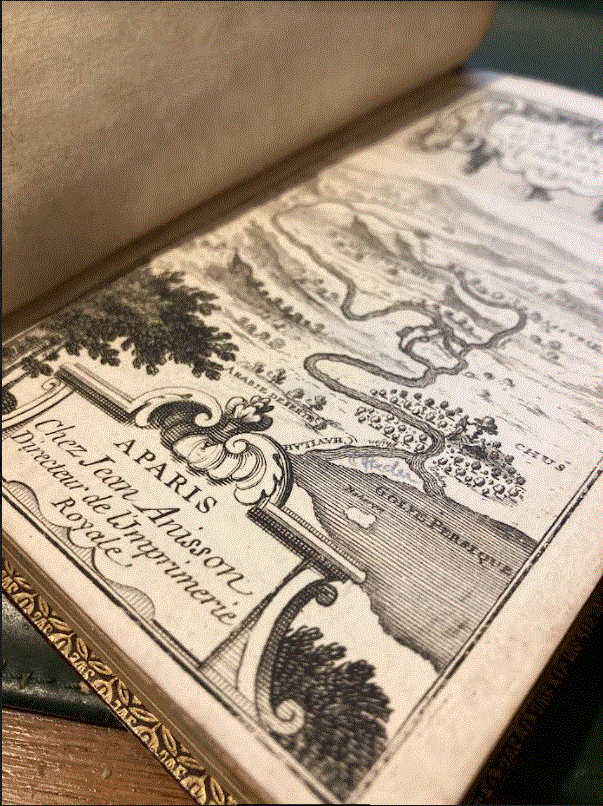Father Huet, or A Map to a Fool’s Paradise
- by Thibault Ehrengardt

There was a time not that far away when learned people could spend their lives trying to determine the exact location of the terrestrial Paradise described in the first book of the Bible. Father Daniel Huet (1630-1721), member of the renowned Académie française and Bishop of Avranches, France, was one of them. He could speak Latin (of course), Greek and Hebrew. He had studied geography, history and theology. He also thought that Moses was the actual writer of the book of Genesis, and he lived in a 6,000 year-old world—as the Bible told him. Human affairs were uncertain, but the Bible was infallible. So when he read about the Garden of Eden, he started to search for it. In 1691, he published a book with a map showing the precise location of the said garden—in the Middle East, in today’s Iraq.
This is a lovely in-12 book, neatly printed by Jean Anisson in 1691. Anisson was at the head of the royal printing, and he knew how to put a book together indeed. This one is illustrated with a frontispiece and a folding map. The former is a gorgeous naive representation of the Persian Gulf featuring the rivers said to cross the garden in the Bible. On the right, two characters are standing under a big tree in the middle of a small wood—Adam and Eve in the Garden! There’s no suspense in this book as Father Huet unveils the conclusion of his researches as soon as the preface: “I therefore declare that the terrestrial Paradise was located alongside the canal formed by the reunion of the Tiger and the Euphrates rivers, between the place where they join and the place where they split again before running into the Persian Gulf.” Then he endeavours to demonstrate.
This is an extraordinary book, written by a true erudite. His arguments are crystal clear—a keen etymologist, he analyzes the origin of words in the various early translations of the Holy Scriptures, and the geographical clues given by the Bible. He also quickly lists some previous theories regarding the situation of the terrestrial Paradise: “Some placed it in the third sky, the fourth one, in the moon’s sky, or on the moon itself, upon a mountain, close to the moon’s sky, in the middle region of the air, on Earth, under the Earth, in a remote and hidden place, unknown to man. Some placed it under the Arctic pole, in Tatary, where the Caspian Sea is today. Some placed in the Tierra Del Fuego, on the bank of the Ganges River, in the island of Ceylon, (...) in China, in America (...), upon the mountains of the moon.” We know that when he reached the mouth of the Orinoco River, Christopher Columbus (who knew his catechism) thought he had reached the gateway to the Garden. He believed that his ship would then slowly rise on a huge terrestrial excrescence on the top of which he expected to find the garden! This geographical curiosity had, he said, the shape of a woman’s nipple—Paradise on Earth, indeed.
Nowadays, we read Huet’s book with a mixed feeling of ridicule and admiration. To be honest, if we consider theology from a mythological point of view, we must admit that he is probably right about the situation of the Garden of Eden. But the initial parameter of his logical demonstration is totally distorted. As we know today, the world wasn’t 6,000 years-old; and Moses didn’t write Genesis; and there never was such thing as a “first man”, and a “first woman” created out of nothing, or an evil snake with legs, or a tree of knowledge. Science has taught us so. But science can’t take everything away from the Bible. The book of Genesis tells one of the most beautiful stories ever written by Man. It is a parable about the birth of life, and death, and man’s heartbreaking condition here on Earth. It sure makes many people‘s lives more bearable. But it is just a tale, Mr Huet. It doesn’t mean there’s no truth in it, but that there’s likely no physical counterpart to it. As Voltaire said, God has probably sent us the Bible so we would become better believers rather than better geographers.
Situation du Paradis terrestre can’t be judged by today’s standards. Not only would it be unfair but it would also be a form of ignorance. This book is a testimony of what fascinated the most intelligent men of their time. As a matter of fact, it is still sought-after today, and you’ll hardly find a good copy (make sure the folding map is not missing) for less than 700 euros. There were only three copies listed for sale on Abebooks when those lines were written. All were first French editions from 1691. In 1701, a second edition—although the title page curiously reads “seventh edition”— came out in Amsterdam. It features a different and gorgeous frontispiece with Moses showing a geographer a map of the terrestrial Paradise. There’s also a new preface by Huet, which is very instructive as the author answers the critics raised by the first edition of his book—it proves that the location of the Garden of Eden was a hot issue in 1691. This edition (most likely the second one, as no copy of the alleged 2nd, 3rd, 4th, 5th or 6th ones is to be found anywhere) seems to be very rare, and I couldn’t spot any for sale on the Internet. What I found was the Italian translation of 1737 (Venetia), listed on Rare Book Hub. Father Huet was already dead by then—and hopefully resting in this beautiful garden where there’s no night.